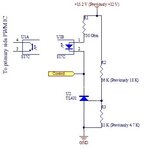HighTechPower
Member level 5
Hi. I recently made 1.5 A charger for 12 V, 7 Ah lead acid batteries. I'm reading battery voltage using microcontroller ADC with resistor divider network. ADC reads while battery is charging and red LED is blinking. When it is charged it should activate a buzzer (depending on whether buzzer activation switch is on or not) and green LED should light up. Sometime it reads correct value and some time it shows amazingly battery as charged even when it is in charging phase and voltage is much lower when measured using multimeter. Any idea how to fix this issue? This circuit converts any 12 V switching power supply into 1.5 A battery charger circuit while raising it's voltage to 15.2 V (after diode D3 I get 14.8 V max). Then control pin is connected directly to optocoupler LED's cathode pin which controls the power supply feedback.
Please attached here find the schematic and code.
Green LED normally lights up at 14.48 V (even then is not it too early as compared to 820 ADC value. Also note I have limitation that battery voltage does not rise above 14.5 V though it's new battery that is why I by trial and error chosen 820 for 14.48 V).
Please attached here find the schematic and code.
C:
// PIC12F683 Configuration Bit Settings
// 'C' source line config statements
// CONFIG
#pragma config FOSC = INTOSCIO // Oscillator Selection bits (INTOSCIO oscillator: I/O function on RA4/OSC2/CLKOUT pin, I/O function on RA5/OSC1/CLKIN)
#pragma config WDTE = OFF // Watchdog Timer Enable bit (WDT disabled)
#pragma config PWRTE = OFF // Power-up Timer Enable bit (PWRT disabled)
#pragma config MCLRE = OFF // MCLR Pin Function Select bit (MCLR pin function is digital input, MCLR internally tied to VDD)
#pragma config CP = OFF // Code Protection bit (Program memory code protection is disabled)
#pragma config CPD = OFF // Data Code Protection bit (Data memory code protection is disabled)
#pragma config BOREN = OFF // Brown Out Detect (BOR disabled)
#pragma config IESO = OFF // Internal External Switchover bit (Internal External Switchover mode is disabled)
#pragma config FCMEN = OFF // Fail-Safe Clock Monitor Enabled bit (Fail-Safe Clock Monitor is disabled)
// #pragma config statements should precede project file includes.
// Use project enums instead of #define for ON and OFF.
#include <xc.h>
#define _XTAL_FREQ 4000000
void init_micro (void);
void init_timer (void);
void init_adc (void);
void read_adc(void);
static int adc = 0, toggle_flag = 1, timer_flag = 0, adc_flag = 0;
static int counter_a = 0;
#define LED_CHARGING GP4 //RED LED
#define LED_CHARGED GP5 //GREEN LED
#define BUZZER GP2 //BUZZER
#define TRUE 1
#define FALSE 0
#define PB_SWITCH GP3 //BUZZER ON/OFF SWITCH
#define POWER_GOOD GP0 //ACTIVATES THE RESISTOR DIVIDER
void main (void)
{
init_micro();
init_adc();
init_timer();
do
{
if(adc_flag)
{
read_adc();
if(adc < 820) //BATTERY NOT FULL
toggle_flag = TRUE;
else if(adc >= 820) //BATTERY FULL
toggle_flag = FALSE;
adc_flag = FALSE;
}
if(timer_flag)
{
counter_a++;
timer_flag = FALSE;
}
if(counter_a >= 10)
{
counter_a = 0;
if(toggle_flag)
{
LED_CHARGING ^= 1;
LED_CHARGED = 0;
BUZZER = 0;
}
else if(!toggle_flag)
{
LED_CHARGING = 0;
LED_CHARGED = 1;
if(PB_SWITCH)
BUZZER ^= 1;
else if(!PB_SWITCH)
BUZZER = 0;
}
}
}
while(TRUE);
}
void init_micro (void)
{
OSCCON = 0b01100111;
TRISIO = 0b00001010;
CMCON0 = CMCON0 | 0b00000100;
ANSEL = 0b01010010;
GPIO = 0b00000000;
POWER_GOOD = TRUE;
__delay_ms(100);
}
void interrupt team_isr()
{
if(TMR1IF)
{
TMR1H = 0xCF;
TMR1L = 0x2C;
timer_flag = TRUE;
TMR1IF = 0;
}
if(ADIF)
{
adc_flag = TRUE;
ADIF = 0;
GO_nDONE = 1;
}
}
void init_timer (void)
{
T1CON = 0b00110100;
TMR1H = 0xCF;
TMR1L = 0x2C;
TMR1IE = 1;
PEIE = 1;
GIE = 1;
TMR1ON = 1;
TMR1IF = 0;
}
void init_adc (void)
{
ADCON0 = 0b10000100;
ADON = 1;
ADIF = 0;
ADIE = 1;
PEIE = 1;
GIE = 1;
GO_nDONE = 1;
}
void read_adc (void)
{
adc = (((unsigned)ADRESH << 8) | ADRESL);
}Green LED normally lights up at 14.48 V (even then is not it too early as compared to 820 ADC value. Also note I have limitation that battery voltage does not rise above 14.5 V though it's new battery that is why I by trial and error chosen 820 for 14.48 V).
Attachments
Last edited:
